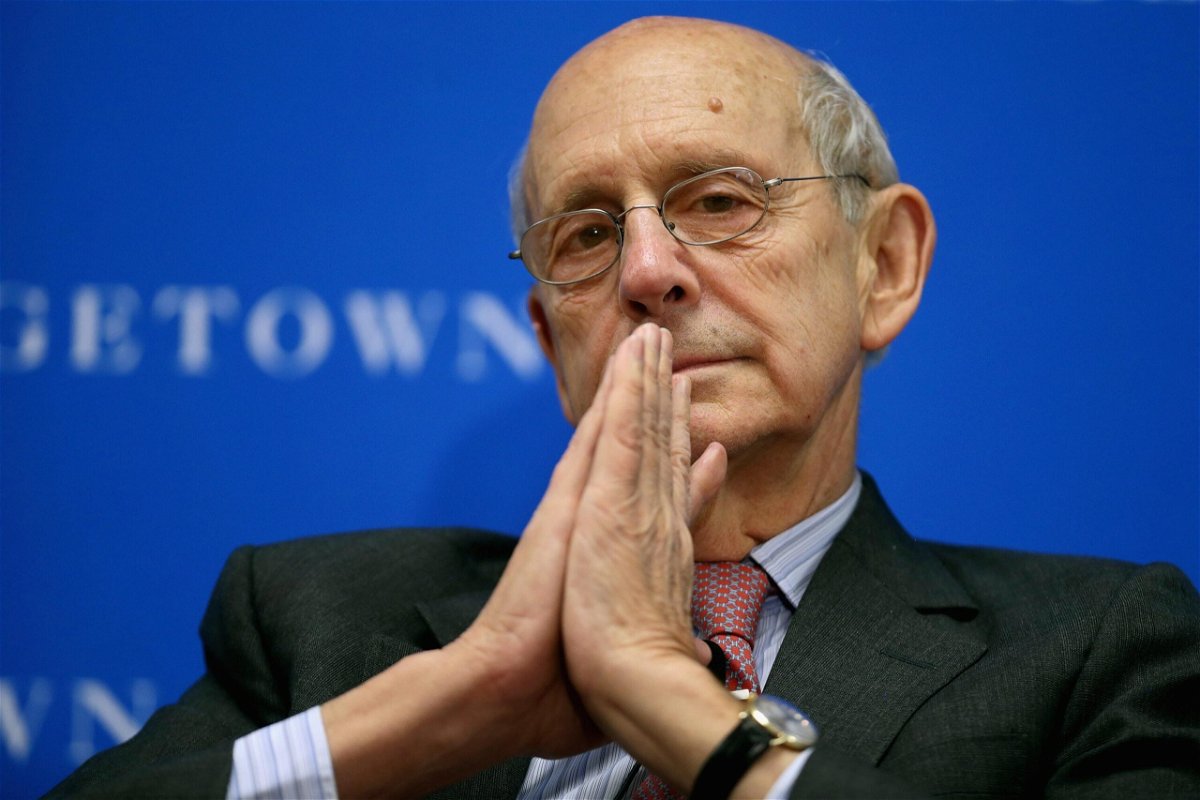Justice Stephen Breyer’s most notable opinions and dissents

During his nearly three-decade tenure
By Joan Biskupic, CNN legal analyst & Supreme Court biographer
During his nearly three-decade tenure, Supreme Court Justice Stephen Breyer has authored a number of important opinions. His style is straightforward, without rhetorical flourish and marked by a tendency toward numbered points.
A former law professor, he readily delves into the intricacies of federal statutes. But he also has demonstrated a pragmatism and tried to show in his opinions an understanding of how the words of the court would impact the lives of individual Americans.
Here are some of Breyer’s most notable writings to date:
Abortion
Stenberg v. Carhart. A 2000 case testing a Nebraska prohibition on an abortion procedure labeled “partial birth” and medically known as dilation and evacuation (D&E).
Breyer wrote for the majority in what would become the first of a series of abortion opinions he authored over the next two decades. Before assessing the Nebraska law in light of cases that forbid government from placing an “undue burden” on women seeking abortion, Breyer addressed the dueling public interests.
“We again consider the right to an abortion. We understand the controversial nature of the problem. Millions of Americans believe that life begins at conception and consequently that an abortion is akin to causing the death of an innocent child; they recoil at the thought of a law that would permit it. Other millions fear that a law that forbids abortion would condemn many American women to lives that lack dignity, depriving them of equal liberty and leading those with least resources to undergo illegal abortions with the attendant risks of death and suffering.”
“Taking account of these virtually irreconcilable points of view, aware that constitutional law must govern a society whose different members sincerely hold directly opposing views, and considering the matter in light of the Constitution’s guarantees of fundamental individual liberty, this Court, in the course of a generation, has determined and then redetermined that the Constitution offers basic protection to the woman’s right to choose. …”
“The question before us is whether Nebraska’s statute, making criminal the performance of a ‘partial birth abortion,’ violates the Federal Constitution, as interpreted in Planned Parenthood of Southeastern Pa. v. Casey (1992), and Roe v. Wade (1973). We conclude that it does for at least two independent reasons. First, the law lacks any exception ‘for the preservation of the . . . health of the mother.’ Second, it ‘imposes an undue burden on a woman’s ability’ to choose a D&E abortion, thereby unduly burdening the right to choose abortion itself.”
Twenty years later, in June Medical Services v. Russo, Breyer authored the judgment of the majority striking down a Louisiana law that required physicians who perform abortions in clinics to obtain “admitting privileges” at a local hospital. (Such credentialing can be difficult for clinic physicians to obtain, and lower court judges have found that they do not ensure greater health benefits for women.)
Breyer’s opinion, however, was penned only for a plurality of the court, joined by Justices Ruth Bader Ginsburg, Sonia Sotomayor and Elena Kagan. Chief Justice John Roberts cast the fifth vote to strike down the Louisiana regulation but wrote separately to explain that his rationale differed from Breyer’s. Much of Breyer’s decision was tied to his 2016 decision for a majority (with Justice Anthony Kennedy still on the court) in Whole Woman’s Health v. Hellerstedt that invalidated a similar Texas law.
Breyer began with the legal standard derived from past Supreme Court cases highlighting a woman’s constitutional right to end a pregnancy and that government may not unduly burden that right. A key precedent is the 1992 Planned Parenthood of Southeastern Pennsylvania v. Casey.
“In Whole Woman’s Health v. Hellerstedt (2016), we held that ‘[u]nnecessary health regulations that have the purpose or effect of presenting a substantial obstacle to a woman seeking an abortion impose an undue burden on the right’ and are therefore ‘constitutionally invalid.’ We explained that this standard requires courts independently to review the legislative findings upon which an abortion-related statute rests and to weigh the law’s ‘asserted benefits against the burdens’ it imposes on abortion access. The Texas statute at issue in Whole Woman’s Health required abortion providers to hold ‘active admitting privileges at a hospital’ within 30 miles of the place where they perform abortions. …”
“In this case, we consider the constitutionality of a Louisiana statute, Act 620, that is almost word-for-word identical to Texas’ admitting-privileges law. As in Whole Woman’s Health, the District Court found that the statute offers no significant health benefit. It found that conditions on admitting privileges common to hospitals throughout the State have made and will continue to make it impossible for abortion providers to obtain conforming privileges for reasons that have nothing to do with the State’s asserted interests in promoting women’s health and safety. And it found that this inability places a substantial obstacle in the path of women seeking an abortion. …”
“Since Casey, we have repeatedly reiterated that the plaintiff ‘s burden in a challenge to an abortion regulation is to show that the regulation’s ‘purpose or effect’ is to ‘plac[e] a substantial obstacle in the path of a woman seeking an abortion of a nonviable fetus.'”
School Desegregation
Parents Involved in Community Schools v. Seattle School District No. 1. Breyer wrote the dissenting opinion for four liberals when the conservative majority invalidated school integration plans in Seattle and Louisville in 2007. He particularly took issue with Roberts’ statement, as Roberts rejected the integration plans, that “the way to stop discrimination on the basis of race is to stop discriminating on the basis of race.”
“… I do not claim to know how best to stop harmful discrimination; how best to create a society that includes all Americans; how best to overcome our serious problems of increasing de facto segregation, troubled inner city schooling, and poverty correlated with race. But, as a judge, I do know that the Constitution does not authorize judges to dictate solutions to these problems. Rather, the Constitution creates a democratic political system through which the people themselves must together find answers. And it is for them to debate how best to educate the Nation’s children and how best to administer America’s schools to achieve that aim. The Court should leave them to their work. And it is for them to decide, to quote the plurality’s slogan, whether the best ‘way to stop discrimination on the basis of race is to stop discriminating on the basis of race.’ …”
“Consequently, the Court’s decision today slows down and sets back the work of local school boards to bring about racially diverse schools. … Finally, what of the hope and promise of Brown? For much of this Nation’s history, the races remained divided. It was not long ago that people of different races drank from separate fountains, rode on separate buses, and studied in separate schools. In this Court’s finest hour, Brown v. Board of Education challenged this history and helped to change it. For Brown held out a promise. It was a promise embodied in three Amendments designed to make citizens of slaves. …”
“The last half-century has witnessed great strides toward racial equality, but we have not yet realized the promise of Brown. To invalidate the plans under review is to threaten the promise of Brown. The plurality’s position, I fear, would break that promise. This is a decision that the Court and the Nation will come to regret. I must dissent.”
Ten Commandments
Van Orden v. Perry. In 2005, Breyer wrote the decisive opinion that allowed a four-decade old Ten Commandments display at the Texas Capitol to remain but forbade framed displays of the Ten Commandments on the walls of McCreary County, Kentucky, courthouses. He opened by referring to the First Amendment guarantee that government “shall make no law respecting an establishment of religion, or prohibiting the free exercise thereof.”
“The First Amendment’s Religion Clauses … seek to ‘assure the fullest possible scope of religious liberty and tolerance for all.’ They seek to avoid that divisiveness based upon religion that promotes social conflict, sapping the strength of government and religion alike. They seek to maintain that ‘separation of church and state’ that has long been critical to the ‘peaceful dominion that religion exercises in [this] country,’ where the ‘spirit of religion’ and the ‘spirit of freedom’ are productively ‘united’ …”
“As far as I can tell, 40 years passed in which the presence of this monument, legally speaking, went unchallenged (until the single legal objection raised by petitioner). And I am not aware of any evidence suggesting that this was due to a climate of intimidation. Hence, those 40 years suggest more strongly than can any set of formulaic tests that few individuals, whatever their system of beliefs, are likely to have understood the monument as amounting, in any significantly detrimental way, to a government effort to favor a particular religious sect, primarily to promote religion over nonreligion. … Those 40 years suggest that the public visiting the capitol grounds has considered the religious aspect of the tablets’ message as part of what is a broader moral and historical message reflective of a cultural heritage. … This case also differs from McCreary County, where the short (and stormy) history of the courthouse Commandments’ displays demonstrates the substantially religious objectives of those who mounted them, and the effect of this readily apparent objective upon those who view them. That history there indicates a governmental effort substantially to promote religion, not simply an effort primarily to reflect, historically, the secular impact of a religiously inspired document. And, in today’s world, in a Nation of so many different religious and comparable nonreligious fundamental beliefs, a more contemporary state effort to focus attention upon a religious text is certainly likely to prove divisive in a way that this longstanding, pre-existing monument has not. …”
“… [W]here the Establishment Clause is at issue, we must ‘distinguish between real threat and mere shadow.'”
Death penalty
Glossip v. Gross. In 2015, Breyer, joined by Ginsburg, dissented from a decision that rejected Death Row defendants’ challenge to a drug used in executions and used his opinion to broadly question the constitutionality of capital punishment.
“[R]ather than try to patch up the death penalty’s legal wounds one at a time, I would ask for full briefing on a more basic question: whether the death penalty violates the Constitution. The relevant legal standard is the standard set forth in the Eighth Amendment. The Constitution there forbids the ‘inflict[ion]’ of ‘cruel and unusual punishments.’ Nearly 40 years ago, this Court upheld the death penalty under statutes that, in the Court’s view, contained safeguards sufficient to ensure that the penalty would be applied reliably and not arbitrarily. The circumstances and the evidence of the death penalty’s application have changed radically since then. Given those changes, I believe that it is now time to reopen the question.”
“In 1976, the Court thought that the constitutional infirmities in the death penalty could be healed; the Court in effect delegated significant responsibility to the States to develop procedures that would protect against those constitutional problems. Almost 40 years of studies, surveys, and experience strongly indicate, however, that this effort has failed. Today’s administration of the death penalty involves three fundamental constitutional defects: (1) serious unreliability, (2) arbitrariness in application, and (3) unconscionably long delays that undermine the death penalty’s penological purpose. Perhaps as a result, (4) most places within the United States have abandoned its use. …”
“For it is those changes, taken together with my own 20 years of experience on this Court, that lead me to believe that the death penalty, in and of itself, now likely constitutes a legally prohibited “cruel and unusual punishmen[t].”
Immigrant detention
Jennings v. Rodriguez. In 2018, Breyer dissented as the majority ruled that immigrants, including asylum seekers, held in detention, even for long periods, do not have a right to periodic bail hearings, joined by Ginsburg and Sotomayor; Breyer read portions of his dissenting statement from the bench, a step that justices take when they believe the majority took a seriously wrong turn in the law and want to call public attention to it.
“The Government has held all the members of the groups before us in confinement for many months, sometimes for years, while it looks into or contests their claims. But ultimately many members of these groups win their claims and the Government allows them to enter or to remain in the United States.”
“… The relevant constitutional language, purposes, history, traditions, context, and case law, taken together, make it likely that, where confinement of the noncitizens before us is prolonged (presumptively longer than six months), bail proceedings are constitutionally required. …”
“The bail questions before us are technical but at heart they are simple. We need only recall the words of the Declaration of Independence, in particular its insistence that all men and women have ‘certain unalienable Rights,’ and that among them is the right to ‘Liberty.’ We need merely remember that the Constitution’s Due Process Clause protects each person’s liberty from arbitrary deprivation. And we need just keep in mind the fact that, since Blackstone’s time and long before, liberty has included the right of a confined person to seek release on bail. It is neither technical nor unusually difficult to read the words of these statutes as consistent with this basic right. I would find it far more difficult, indeed, I would find it alarming, to believe that Congress wrote these statutory words in order to put thousands of individuals at risk of lengthy confinement all within the United States but all without hope of bail.”
The-CNN-Wire
™ & © 2022 Cable News Network, Inc., a WarnerMedia Company. All rights reserved.



